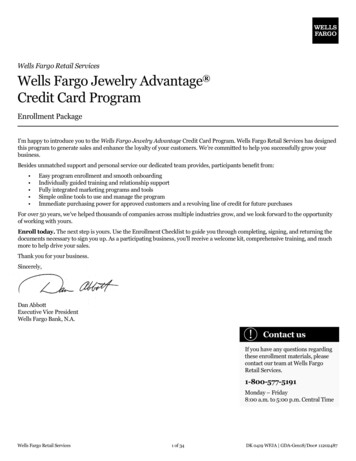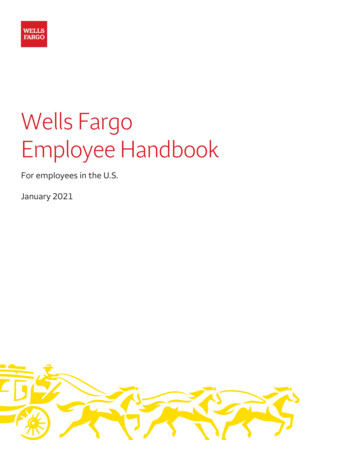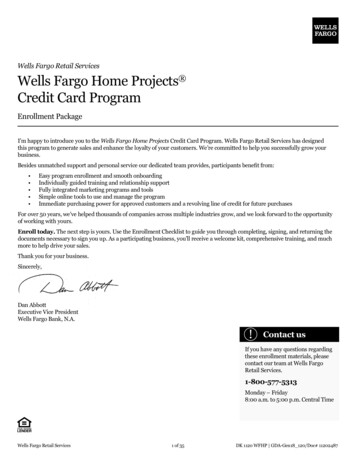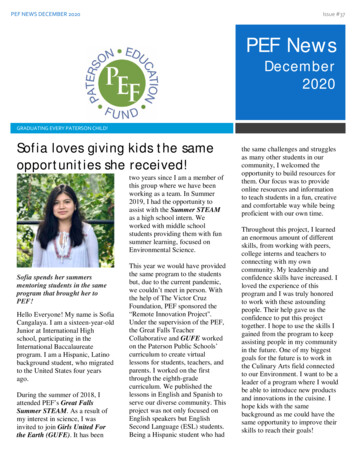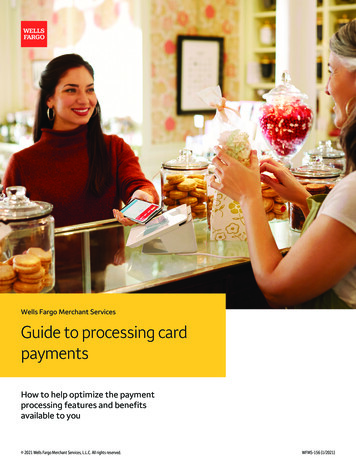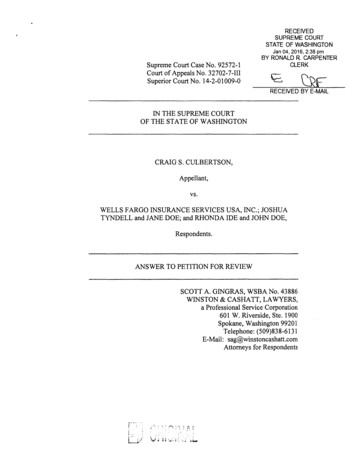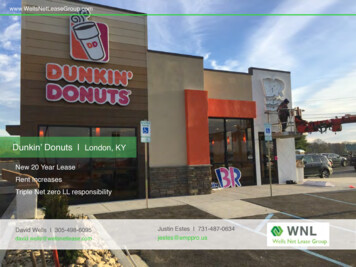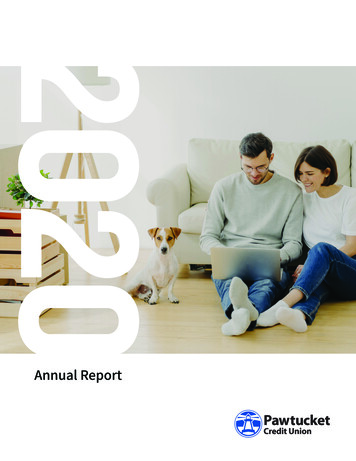
Transcription
2020Annual Report
Contents02Letter from CEO21Our Performance22Operating Committee24Board of Directors26COVID-19 and Sustainability332020 Financial Report243Stock Performance
“Wells Fargo plays an important rolein our communities and our country —and this has never been more true thanin 2020.”I cannot help but look back and think how littlewe understood one year ago of what 2020 wouldbring for the world, our country, and our company.The devastation caused by COVID-19 on globalpublic health is clear, but we are still strugglingto comprehend the full economic and social impactof the virus. Vaccines will hopefully bring to an endthe health risks, but there is much to do to enablea full, fair, and equitable economic and social recovery.Charles W. ScharfCEOWells Fargo & Company22020 Annual ReportSupporting Our Employees,Communities, and CustomersI said last year that Wells Fargo plays an importantrole in our communities and our country — and thishas never been more true than in 2020. We believewe have both an obligation to do all we can andare in a position to provide meaningful supportto our employees, communities, and customers.That is just what we did throughout thisunprecedented year.
We prioritized employee and customer safety while recognizing that we were anessential service and needed to be available to support our customers. We quicklyenabled over 200,000 employees to work from home, something we would not haveconsidered possible just weeks before. We kept at least 70% of our branches openwhile implementing CDC-recommended safety protocols. We expanded digitalaccess and deployed new tools — including new limits for mobile deposits andwires, new digital mortgage deferment tools, and expanded e-signature support —to make access easier and safer for customers.We extended significant credit to our clients during the height of the crisis.In March alone, our commercial customers utilized over 80 billion of theircommitted loan facilities. In 2020, we also provided significant accommodations,including deferring payments and waiving fees for 3.6 million consumer and smallbusiness customers. We suspended residential property foreclosures, evictions,and involuntary auto repossessions.We participated in the Paycheck Protection Program (PPP) and funded 194,000 loanstotaling over 10.5 billion. (We also are actively participating in the next round of PPPin 2021.) We were proud to help smaller businesses through this program with 61%of our loans being for amounts less than 25,000, 84% of loans going to companiesthat had fewer than 10 employees, and 90% for businesses with less than 2 millionin annual revenue. In addition, 41% of loans went to companies in low-to-moderateincome areas or at least 50% minority census tracts.In addition, in 2020 we voluntarily committed to donate all of our gross processingfees — approximately 420 million — by creating the Open for Business Fund, whichprovides support to struggling small businesses impacted by COVID-19. Of thiscommitment, we deployed 85 million in 2020 and will continue to deploy thesefunds through 2022.We continued to pay all employees during the crisis, made a cash award toapproximately 165,000 employees who make less than 100,000 per year,and made an additional special payment to those working on the front linesas a way of recognizing their unique contributions. We granted eligible employeesadditional days off so they could arrange for child care and provided financial supportfor those in need. We made a grant to the WE Care employee relief fund, which isavailable to employees affected by COVID-19 and who have limited resources.3
In addition, we supported our communities beyond these efforts as we directeda total of 475 million in charitable giving (including the 85 million deployedfrom our Open for Business Fund noted above) to help address food insecurity,small business support, housing stability and other urgent community needs.“We extended significant credit to ourclients during the height of the crisis.In March alone, our commercial customersutilized over 80 billion of their committedloan facilities. In 2020, we also providedsignificant accommodations, includingdeferring payments and waiving feesfor 3.6 million consumer and smallbusiness customers.”We are just one of many companies that provided necessary support — and wewill continue to do so as the impact of the pandemic continues. The economic andoperational impact of the pandemic on Wells Fargo has been significant and hascertainly added to the complexity of our work, but I am proud of what we havedone to continue to deliver for our customers, communities, and employees.Company AssessmentWhen writing this letter last year, I had been at the company for four months andshared my initial assessment of our challenges and opportunities, both of whichwere significant. I described my early thoughts on the changes that were necessaryfor Wells Fargo to put the past behind us and capture the significant potential ofthis great franchise.One year later, I continue to believe our franchises are world class, are in the sweetspot of providing necessary financial services to consumers and companies of allsizes, and when working together, are even more valuable. But, as I’ve learned more,the extent of the change required has become clearer and is more significant thanI initially assessed.We are addressing this head-on and moving with an extreme sense of urgency toset clear priorities, which include building the proper foundation first and foremost.And we are also changing the culture where necessary, making management changes42020 Annual Report
as needed, instituting new disciplines to set strategy and manage the company, andrefining our business mix so we are positioned to invest appropriately going forward.2020 Financial PerformanceOur financial performance this past year was challenged by both the externaloperating environment and the necessary work to put our substantial legacyissues behind us.In terms of the significant drivers, we built large loan loss reserves to preparefor the economic impact caused by the pandemic. Low interest rates negativelyimpacted our net interest income, and we were limited in our ability to offset thisgiven our constraints of operating under an asset cap. We recognized restructuringcharges to accelerate our efficiency initiatives (more on this later), and we continuedto spend significant amounts to build out our risk and control infrastructure as wellas to provide remediation for customers to address our historical shortcomings.And while it was absolutely the right thing to do, COVID-19 increased our expensesand reduced revenue as we took actions to support our customers and protectour employees.Wells Fargo generated 3.3 billion in net income, or 41 cents per diluted commonshare. Our revenue declined 15% from the previous year, while noninterest expensedeclined 1%, but remained at an elevated level largely due to customer remediationaccruals and restructuring charges. Provision expense for credit losses increased 11.4 billion with large reserve builds in the first half of 2020 reflecting forecastedcredit deterioration due to the COVID-19 pandemic.Loans outstanding declined 8% in 2020, as both commercial and consumer customersadopted a more cautious stance and our commercial clients were able to access thecapital markets. Deposits grew 81.8 billion, or 6%, from a year ago as declines incommercial deposits driven by our efforts to remain under the asset cap were morethan offset by growth in consumer deposits helped by strong fiscal stimulus,reduced customer spend, and utilization of deferral programs.While we built significantly higher loan loss reserves, actual charge-offs weremuch lower than anticipated, aided by government stimulus programs and deferralprograms that are helping customers navigate the challenges of the pandemic.Our net charge-off rate increased modestly in 2020 — to 0.35% of average loans —but the ultimate timing and magnitude of losses will depend on the broader recovery.Despite the challenging environment, the strength of our balance sheet was evidentthroughout the year. Our capital and liquidity levels remained well above regulatoryminimums (Common Equity Tier 1 of 11.6% vs. 9% minimum and Liquidity CoverageRatio of 133% vs. 100% minimum at year-end) and the results of the two FederalReserve stress tests confirmed our strong capital position. Given the economicuncertainty and the temporary restrictions imposed by the Federal Reserve Bank,5
we took appropriate measures to maintain strong capital. We suspended sharerepurchases starting in March, and made the difficult decision to reduce ourcommon stock dividend from 51 cents per share to 10 cents per share. That said,we have significant excess capital, and as the economic recovery becomes clearerand restrictions on capital distributions are lifted, we expect to be able to returncapital to shareholders through a combination of higher dividends and sharebuybacks. Returning capital to shareholders over time remains a priority.Business and Strategic ReviewWe have conducted rigorous reviews of our businesses with an eye towardsassessing their strategic fit to the company, assessing the risk/return profile,and creating a roadmap for improved operational and financial performance.Our goal is to be the preeminent provider of financial services in the U.S. andin doing so seek to reward all stakeholders, including investors, employees,customers, and the communities where we do business.We believe our model as an integrated U.S. bank with significant scale and breadthof capabilities positions us to achieve our goal, and that we are one of only a few thathave this position — though we do compete with thousands. Our strategy is aboutbecoming even crisper about serving our target market and taking actions necessaryto leverage our strong competitive position.“Our goal is to be the preeminent provider offinancial services in the U.S. and in doing soseek to reward all stakeholders, includinginvestors, employees, customers, and thecommunities where we do business.”We are clear on who we are. We target U.S. consumers and businessesof all sizes. We do have capabilities outside of the U.S. but these activitiesare built predominantly to support our core U.S. customers with their globalneeds or are in domains where we have the scale and expertise to competelocally. We provide the same services for both consumers and companies ofall sizes — though the words we use to describe what we do are sometimesdifferent. We are a trusted advisor and provide core banking services includingdeposits, capital (private and public access to debt and equity), payments, andinvestments. Our scale and sophistication allows us to have a differentiatedpresence and technology platform few can compete with.62020 Annual Report
I firmly believe we have the right businesses at Wells Fargo today to achieveour goal. Our individual businesses are strong and valuable. We have excellentindividual franchises that compare favorably to competitors large and small.We have the products, services, people, and scale to be a leader in each, and eachbusiness has opportunities to serve customers more broadly and improve its ownfinancial profile. I’ll briefly explain why I feel we are well positioned in each of ourfour operating segments.Consumer Banking and Lending provides necessary financial productsto consumers and small businesses, including deposits, loans, payments,and investments. The quality and scale of our branches and digital capabilitiesare matched by few. We serve approximately 65 million customers across ourbusinesses and believe our bank branch footprint will continue to be a competitiveadvantage. We have bank branches in 25 of the largest 30 markets1 in the U.S.and 27 of the 30 fastest growing markets1 in the country. A Wells Fargo branchor ATM is within two miles of over half of the U.S. census households and smallbusinesses in our footprint.“I firmly believe we have the rightbusinesses at Wells Fargo todayto achieve our goal.”Our physical presence will continue to be an important asset but digital capabilitieswill become an ever more important complement in our business model, and our scalegives us an efficient platform to spend what is necessary, attract the necessary talent,and partner with third parties. Our margins should benefit as more activities migrateto our digital platforms.We also have meaningful opportunities to improve margins as we rationalize ourreal estate footprint, become more efficient in our branch staffing, and reduceour support costs.Wealth and Investment Management provides us with unique breadth and scaleto serve the ever more complicated needs of investors. We have one of the largestand most complete platforms in the industry with over 13,500 advisors who serve2.8 million customers, all with access to the Wells Fargo Investment Institute’scapabilities. We believe that the need for professional investment and planningadvice will grow in importance as broad-based economic advancement continuesin this country.1. Based on Core-Based Statistical Areas.7
We expect our margins to increase as we combine three different platforms intoone supported by a common set of capabilities. We have significant opportunitiesto provide banking solutions, both lending and deposits, to this customer base,and our independent broker (FiNet) and registered investment advisor (RIA)channels and digital platforms provide meaningful opportunities for growth.Commercial Banking serves private, family-owned, and small-midsize publiccompanies with core deposit, lending, and payments solutions. We have a leadingand enviable franchise, and our strong local relationships that have been builtover decades complement our branch footprint. Our scale is a big advantage.Our approximately 5,800 bankers serve nearly 480,000 clients. We serve 46 ofthe largest 50 markets1 in the country. Our local teams benefit greatly from theresources and support of our national footprint.We also have significant opportunities to expand our leading franchise bydeepening our client relationships and delivering more of the full enterprise.We have the opportunity to offer more integrated treasury management andpayment services, and to partner more closely with our Corporate and InvestmentBank to deliver a broader set of solutions, like advice and access to capital markets,to our larger middle market customers. Our margins and client experience shouldalso benefit meaningfully as we optimize our coverage model and continue investingin our digital service offerings.“Our local teams benefit greatly fromthe resources and support of ournational footprint.”Corporate and Investment Banking has been a core part of the company formany years. The banks that came together to form Wells Fargo served a widerange of customers, from consumers and small businesses to mid-market corporatesand larger local corporates. Our traditional banking products — deposits, loans, andpayments — formed the basis for most of these relationships. As our corporateclients grew, their banking needs expanded and they wanted access not only to bankcapital but also capital through public markets. Our investment banking and tradingcapabilities are built around satisfying this need and given our status as a trustedpartner, we have also earned the right to be a strategic advisor.We have been disciplined and will remain disciplined in where we compete, but wehave the opportunity to grow our business — not by changing our risk profile, but byleveraging our core relationships and delivering the entire enterprise to these clients.1. Based on Core-Based Statistical Areas.82020 Annual Report
Working Together as One Wells FargoWhile our businesses are strong individually, they are even more powerful whenworking together. Though we talk about separate lines of business, we operateas one company in our communities. Our branches serve consumers and smallbusinesses as well as commercial banking and corporate clients. Our ability tosupport our local communities is based not only on that breadth locally, but alsoon the support and the resources of Wells Fargo nationally.“Though we talk about separate linesof business, we operate as one companyin our communities.”At times, our lines of business have served as artificial boundaries for us deliveringthe very best for our customers and clients. We are breaking down those barriersto more effectively serve our customers which should add to our profitability andreturns as well. We have opportunities across our entire franchise — but just a fewexamples include: Serving different consumer segments with deposit, lending, investment,and service capabilities built around their specific needs Offering integrated payments and treasury services solutions to our clients Providing investment banking and markets solutions to our large CommercialBanking client baseAs part of our strategic review, we identified certain businesses that aren’t coreto our mission as outlined above. In the past few months, we have announcedsales of or our intention to exit the student loan business, international wealthmanagement, and direct equipment finance in Canada. We are also in the processof exploring options for Asset Management, Corporate Trust, and our rail portfolio.We are focusing our efforts on our core, scaled businesses, and these other activities,which may be good businesses, are not consistent with our go-forward corestrategic priorities.Significant Transformation Is NecessaryTo deliver on the business opportunities, we are changing our operating modelat its core. Historically, Wells Fargo has been run in what has been described to meas the “federated” business model. Business leaders had great latitude to operateindependently and work together if they saw fit. Some worked together, and somedid not. The result was an ineffective control infrastructure, and we did not9
capture the benefit that our breadth and depth of capabilities should provide forour customers and clients. Operating as one company is a different mindset thatdescribes how we expect our leaders to work today.Continuing the Work to Build a Strong and Consistent FoundationOur transformation is dependent on several foundational pillars that we are keenlyfocused on. In many ways they are about getting the basics right but are truly criticalto our success.1. Risk and Control Culture (and Our Regulatory Agenda)Building and implementing an effective risk and control framework across thecompany is an imperative and a core requirement for the management team.Historically we have built a strong culture and operating discipline aroundmanagement of most financial risks including credit, market, liquidity, and capital.But we had not done so with the same rigor in our management of non-financialrisks. Building out this infrastructure is our top priority, and we are doing this workcompletely differently from when I arrived at Wells Fargo. We are moving with a senseof extreme urgency to complete the work, though it will take several years to buildand implement a holistic set of mature processes. Satisfying our regulators shouldbe a byproduct of both the cultural change necessary as well as accomplishingthe specific tasks.The Operating Committee, both individually and collectively, is closely managingthis work now. We now have clarity of responsibility and accountability at multiplelevels across the organization and individuals with the appropriate subject matterexpertise in place. We have formal processes throughout the company to managethe work that is required, and this all feeds into regular Operating Committeereviews. Any issues requiring management attention are reviewed formally multipletimes weekly at regularly scheduled meetings and we review all work streams at leastmonthly in detail.We have clear expectations for management involvement and those expectations arenow part of how we evaluate performance. We have made it clear that this is a criticalpart of our culture, and we are dedicating all resources necessary to accomplish thiswork, and will continue to do so.Relatedly, we’ve also been moving with increased urgency to put our substantiallegacy issues behind us. This includes working through an expansive set of legal andcustomer remediation matters which are almost entirely tied to our historical issues.102020 Annual Report
In doing this work, we are absolutely committed to treating customers fairly. In 2020,we made significant progress and it is absolutely critical that we get this work done sowe can do what is right for customers and move our organization forward.2. Operational Excellence and Strong Management TeamIn the past, we have simply not done what is necessary to put these issues behindus and that is unacceptable. We are clear about our priorities and are focused onconsistent, effective, and efficient execution as a core discipline as never before.New Management TeamWe have transformed the management team by elevating strong internal talentwhile bringing in people with the experience and skills necessary for our success.Our Operating Committee, the 18-member senior-most group responsiblefor running the company, is a new management team. Of the 17 other members(in addition to myself), I have hired nine leaders from outside the company, fourare in different roles, and four were relatively new (less than two years) to thecompany when I arrived. Each member has expertise and experience in their areaof responsibility and brings a diverse set of skills, backgrounds, tenures, andperspectives to our discussions and decisions.“We have transformed the managementteam by elevating strong internal talentwhile bringing in people with the experienceand skills necessary for our success.”Our broader group of senior leaders is also a new team. Nearly half of ourtop 150 leaders are new to their role from the start of 2020, including over40 who are new to our organization.Management ProcessesThe way we run the company is entirely different from what we’ve donehistorically. The Operating Committee meets multiple times per week anddiscusses all important issues across the company. We act as one managementteam, with committee members bringing their expertise and backgrounds to alldiscussions. Diversity of views is imperative. I have always believed that with theright people and all of the relevant facts, the right decisions will get made. We nowhave that in our Operating Committee.11
We have introduced monthly business reviews where we review financial andoperational performance in a regular, disciplined way. In addition to the core financialresults, these reviews include sections on risk and control deliverables, human capital,diversity, strategy, and progress on large projects. We work as a team to ensure we aremoving forward in a disciplined way, using all of the facts available to us, and takinga holistic approach to issues across the entire company.Transparent Financial ReportingHaving the right information to manage the company, and for investors to assess oursuccess, is critical. One of my early observations when I joined the company was thatwe were not managing the company at the level of granularity necessary. As a result,we made changes to the management structure — most notably having more of ourbusinesses report directly to me.That change drove us to completely change our internal reporting to provide us withmore transparency into our performance and underlying business drivers and give usthe information necessary to create plans to improve our performance. This is nowhow we manage the company, with reporting and reviews conducted at a businesslevel at which decisions are made — a big change from what had been the practice.This reporting is our dashboard necessary to manage the company.We have also completely changed our external reporting — with the goal of givinginvestors a clearer understanding of our results, as well as the ability to compare ourbusinesses on a more like-for-like basis to competitors and track our performanceas we do internally. What we now disclose is what we are reviewing internally andour strengths and weaknesses should be clearer than ever, but the potential forimprovement should also be clear.3. Customer Centric Culture and ConductDoing what is right for customers must be at the center of everything we do,and unfortunately, we too often fell short of this in the past. We have been takingdramatic steps to embed this mindset into all of our decisions, which feeds intoall the ways in which we touch customers. This extends from product design andpricing, to our coverage and service models, to how we approach complaints andremediations. And we know it’s all about our actions, not our words.To that end, while we have more work to do, we are making significant progress.In 2020, we rolled out a new set of company Expectations with “Do What’s Right”as one of six core pillars. It sounds simple — but that is the point. These new122020 Annual Report
Expectations are clear and straightforward and guide how we lead ourselves,collaborate with colleagues, and make decisions; they apply to everyone at thecompany and are directly linked to how we evaluate performance.I mentioned this before but our approach to remediating our legacy issues beginsand ends with treating customers fairly. Over the past year, with many of our newleaders, we have been rigorously working through issue by issue with this mindset.“Doing what is right for customersmust be at the center of everythingwe do, and unfortunately, we toooften fell short of this in the past.”Additionally, we deployed a new customer feedback program (Net Promoter System)and Complaints Management Platform to collect and react to customer feedbackand improve the customer experience. We also built our Sales Practices Managementand Oversight program, designed to make sales practices monitoring and reportingmore robust and consistent across the company. And lastly, we just recentlyannounced the launch of an Office of Consumer Practices, a consumer-focusedadvisory group that will partner with our businesses on product development,policies, procedures, training and other areas. All of these efforts are designedto keep the customer front and center and embed that perspective into ourdecision-making. They are also a critical part of strengthening our risk andcontrol infrastructure.4. Technology and InnovationAs our foundational work progresses, in parallel we are intensely focused onbuilding technology and digital solutions that will power our businesses over thelonger term. All of our businesses need to build digital solutions to complementour physical presence. Ultimately, our goal is to transform our business model fromone that is reliant on physical presence and interaction, accentuated by technologysolutions, to one primarily driven by technology platforms and enhanced by physicaldistribution and interaction.13
The events of 2020 only accelerated and confirmed how critical this ongoingmigration will be. What consumers expect is shifting quickly, and the competition —both incumbent and emerging competitors — is greatly increasing. But given thescale of our franchise, the breadth of our products, and the number of ways wetouch customers, we are well positioned to build robust technology platformsand deliver differentiated customer experiences.While we are focusing much of our resources to strengthen our core infrastructure,we are mindful that our competitors, banks and non-banks, are moving quickly andwe must as well.5. Financial StrengthThe safety and security of our financial position should be unquestioned, and to thatpoint, our capital and liquidity levels have historically been strong and remain strong.Despite the turmoil of this past year, our capital and liquidity levels remained well inexcess of regulatory minimums.But as I outlined previously, the impact of COVID-19 on our earnings has beensubstantial. The majority of our business is traditional banking, and when ourcustomers and clients suffer, we do as well. The unemployment rate peaked at14.8% and still stands at 6.3% as of January 2021. Consumer spend has suffered,small businesses have struggled to survive, and many commercial banking and largercorporate customers have seen substantially reduced business activity. Commercialreal estate is suffering from reduced retail store demand, low hotel occupancy, andlittle demand for office space.At the same time, the aggressive actions by the Federal Reserve have helped ensurecapital markets stability, which has helped enable very strong trading and capitalissuance volumes. While our competitors have benefited more than we have fromtheir more significant trading and investment banking businesses, we also recognizethat they went into this environment better positioned than us. Simply put, ourmargins are narrower than is necessary to support appropriate profitability andreturns through environments like today, and we need to change this.“While we are focusing much of ourresources to strengthen our coreinfrastructure, we are mindful thatour competitors, banks and non-banks,are moving quickly and we must as well.”142020 Annual Report
We Are Taking Action, but Not All Is in Our ControlAsset Cap – We remain subject to an asset cap as part of our consent order withthe Federal Reserve, and we must prioritize balance sheet usage more so than ifit were not a limitation. This is a significant constraint, especially given the operatingenvironment in 2020. While there is still significant work to do, I believe we aremaking progress and we are confident in our ability to complete the work andwhen the cap is lifted, we will have more latitude to grow our business andincrease our returns.Capital Return Restrictions – We are also temporarily limited in our abilityto ret
declined 1%, but remained at an elevated level largely due to customer remediation accruals and restructuring charges. Provision expense for credit losses increased 11.4 billion with large reserve builds in the first half of 2020 reflecting forecasted credit deterioration due to the COVID-19 pandemic.

